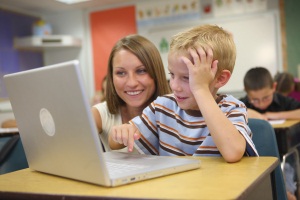Panther Press: Ms. Weatherspoon, July 2019

MODEL RESPONSIBILITY – Albeit cliché, teachers should be reminded that they must practice what they preach. The youngsters watch their teachers’ every move. We can repeat the expectations from morning until dismissal but if there is little or no modeling of responsible technology use, students will not be able to benefit from technology integration throughout each day. One blogger for K12 Staff Development suggests that we model the same expectations we teach our students (Blogger, 2019). If we tell them to keep their phones on silent, for example, then our phones should also be on silent. Modeling is a normal process for the teaching and learning process. This fact leaves us to question why modeling is overlooked when it comes to behaviors. Yes, we are conscious of modeling when it relates to learning – content, but behaviors that facilitate learning content gets lost in translation too often. The millennial students are often tech savvy and can use personal devices and home software with great ease. However, school and district software or technology devices available at school can be quite different. Teachers would do a great service to the students to model responsible use of technology by being prepared to answer questions and guide them safely to destination – independent inquiry.

OUTLINE RESPONSIBILITY – We are existing in the digital age and it seems to go without saying that students have ideas about responsible use and the expectations that teachers and schools have for them when using technology. Assumptions can be dangerous, particularly in education. Teachers access prior knowledge before starting lessons so that they can move forward appropriately and not waste valuable instructional time covering material students already know. Similarly, when integrating technology responsibly, teachers must begin with guidelines for expectations. Blended Learning models and other models of technology integration work better when there is a definitive contract outlining expectations from the beginning. Students and parents should review a document drafted for the program(s) their students will be participating in. An outline of the expectations would work in conjunction with any district codes of conduct; schools can address site specific expectations. Baltimore Schools created an exemplary format for this purpose. This document can be viewed via the Maryland District’s website (https://www.montgomeryschoolsmd.org/uploadedFiles/schools/travilahes/mediacenter/Responsible%20Use%20of%20Technology%20-%20Student%20Expectations.pdf. It covers both the responsible behaviors expected as well as the consequences for failure to utilize responsible behaviors when using technology at school. This step increases opportunities for developing students who are responsible with technology integration and put all stakeholders on the same page. It is a fair and proactive move for school leaders.

INFUSE RESPONSIBILITY- There are innumerous educational benefits for students when teachers and school leaders promote technology integration, as explained by the author of “Technology Integration: New 21st Century Learner” (Blair, 2012). Students expand their audience from only the teacher to a host of viewers that can include their peers locally and from all over the world. Sharing and receiving feedback from multiple audiences is a reflective sharpening tool that is remiss in isolation of teacher student only teaching and learning. Students enjoy safe, responsible ways to communicate and collaborate with other learners. Also, students develop skills such independent edit and revise of work to submit the best possible final product. Through technology infused activities such as creating videos for a class or school Flipgrid, students work on speaking and listening skills as well as revise and editing skills. These are skills that were traditionally taught by rewriting essays. The more students engage responsibly with technology, the more confident they become in their own abilities. Creation activities by their own design makes them active learners who can harness skills and knowledge to use as they further their education and become contributing citizens. Technology integration intensifies the development of the four C’s, according to Principal Blair of the National Association of Elementary School Principals (Blair, 2012). Critical thinking, creativity, communication and collaboration skills are fostered through digital learning.
One school leader, Lieutenant Colonel David Britten, successfully launched a movement in the state of Michigan to bring awareness to shortcomings in state and federal policies that left less fortunate students at the bottom of funding priority lists (Sheninger, 2019). He demonstrated how one could use technology responsibly for professional development, transparency and for a greater cause. Technology became the core teaching and learning platform at the high school Lt. Britten was principal, taking them from one of the lowest performing schools in the state to one of the top 3 schools in the state! That is Responsible Technology Integration.
References
Blair, N. (2012, January/February). NAESP. Retrieved from National Association of Elementary School Principals: https://www.naesp.org/principal-januaryfebruary-2012-technology/technology-integration-new-21st-century-learner
Blogger, P. (2019). PLB. Retrieved from Professional Learning Board: https://k12teacherstaffdevelopment.com/tlb/how-do-we-teach-responsible-use-of-technology/
Officer, C. T. (2018). Montgomery County Public Schools. Retrieved from Montgomery School Maryland: https://www.montgomeryschoolsmd.org/uploadedFiles/schools/travilahes/mediacenter/Responsible%20Use%20of%20Technology%20-%20Student%20Expectations.pdf
Sheninger, E. (2019). Digital Leadership: Changing Paradigms for Changing Times. Corwin Press.